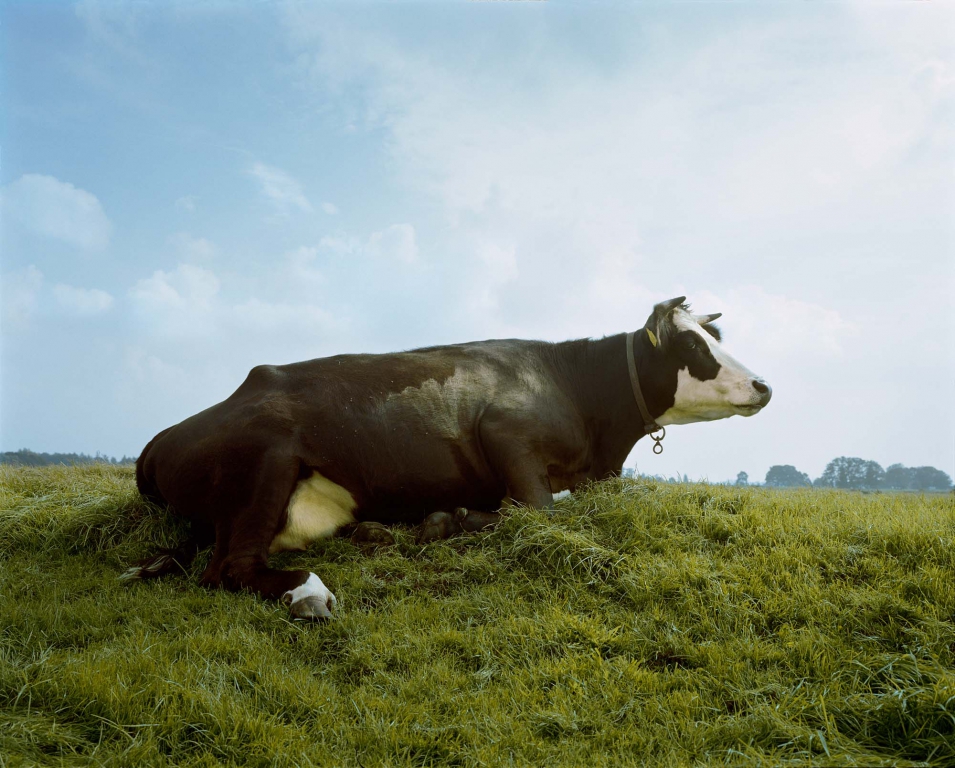The unambiguous title Polder Holland makes it clear what this series by Han Singels is all about: the classic Dutch polder landscape, a landscape which also forms the decor in the new series of panoramas by Hellen van Meene. For Hellen van Meene, the coffin and the mourners are the centrepiece; Han Singels gives pride of place to the cow.
In the footsteps of the Dutch Masters Paulus Potter, Aelbert Cuyp, Gerard Bilders, the Maris brothers and Willem Roelofs, from 2000 Han Singels tramped through North Holland polders, Gelderland water meadows and Utrecht pasturelands to photograph this landscape. While his illustrious predecessors had struck out on foot or on a cart and had taken a sketchbook, Singels set out from Amsterdam with a moped and a camera. Light, air, water, trees, pasturelands, and cows in all varieties and colours are the elements with which these painters created their imagined Dutch landscapes on the canvas – usually back in the atelier. As a photographer, Singels had no choice but to walk, look, and patiently wait for just the right moment, when every element was present in perfect combination – and even then he would have to wait for the darkroom results to know whether the photo had hit the mark. To look at his work is to see, in every one of his photographs, a glimpse of the old Dutch Masters and their 19th-century colleagues at the Hague School.
Han Singels chooses landscapes in which he can easily move around and get close to the cows. He searches for what in Dutch painting is known as a ‘furnished’ landscape, with animals (cows), elevations (dikes, for instance) and ‘wings’ (such as tree stands) in order to define a variety of levels in the image. Singels’ photographs are a timeless version of the Dutch landscape: farms, barns, silos, power pylons, roads and railways are carefully kept out of sight. If he were to allow these kinds of elements in his images, they would unwittingly reintroduce the documentary aspect of photography; the photographs would then no longer be about the Dutch landscape, but about the infrastructure of Dutch agriculture and farming policy.
Han Singels (Brastagi, Indonesia, 1942) studied at the Royal Academy of Art in The Hague (the KABK), the Rijksakademie van Beeldende Kunsten in Amsterdam, and elsewhere, focusing on photography and graphic design. He began his career as a documentary photographer working for newspapers and magazines, and he belongs to a generation of socially engaged photographers who documented the social and political developments of the late 1960s and early 1970s. In the 1980s Singels started concentrating on long-term projects. He made a series on young people (commissioned by the Rijksmuseum Amsterdam, 1983) and another on AIDS patients (commissioned by Stadsarchief Amsterdam and Amsterdams Fonds voor de Kunsten, 1990). In 2007 Singels’ series Polder Holland was exhibited in Huis Marseille, the first time these iconic photographs of cows in the Dutch polder landscape had ever been on display. In 2012 the series was shown in the Gemeentemuseum Den Haag. Singels’ work has been acquired by a wide variety of private and museum collections, and is represented by Galerie Wouter van Leeuwen.

